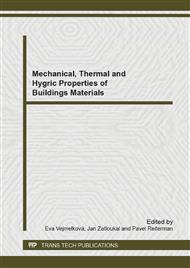[1]
American Society for Testing and Materials (ASTM) C-125. Standard Terminology Relating to Concrete and Concrete Aggregates, (2007).
Google Scholar
[2]
S. Donatello, M. Tyrer, C.R. Cheeseman, Comparison of test methods to assess pozzolanic activity, Cement and Concrete Composites. (2010).
DOI: 10.1016/j.cemconcomp.2009.10.008
Google Scholar
[3]
V.M. Malhotra, Fly Ash, Silica Fume, Slag, and Natural Pozzolans in Concrete, Proceedings Third International Conference, Norway, Detroit, MI (USA), American Concrete Institute, (1989).
DOI: 10.14359/1881
Google Scholar
[4]
C. Medina, M.I. Sánchez de Rojas, M. Frías, Freeze-thaw durability of recycled concrete containing ceramic aggregate, Journal of Cleaner Production. 40 (2013).
DOI: 10.1016/j.jclepro.2012.08.042
Google Scholar
[5]
J.R. Jiménez, J. Ayuso, M. López, J.M. Fernández, J. de Brito, Use of fine recycled aggregates from ceramic waste in masonry mortar manufacturing, Construction and Building Materials. 40 (2013).
DOI: 10.1016/j.conbuildmat.2012.11.036
Google Scholar
[6]
L. Zuda, P. Rovnaník, P. Bayer, R. Černý, Effect of high temperatures on the properties of alkali activated aluminosilicate with electrical porcelain filler. International Journal of Thermophysics. 29(2) (2008) 693-705.
DOI: 10.1007/s10765-007-0311-y
Google Scholar
[7]
V. Tydlitát, J. Zákoutský, P. Volfová, R. Černý, Hydration heat development in blended cements containing fine-ground ceramics, Thermochimica Acta. 543 (2012).
DOI: 10.1016/j.tca.2012.05.022
Google Scholar
[8]
E. Vejmelková, M. Keppert, P. Rovnanikova, Z. Kersner, R. Černý, Properties of Lime Composites Containing a New Type of Pozzolana for the Improvement of Strength and Durability, Composites Part B: Engineering. 43 (2012) 3534-3540.
DOI: 10.1016/j.compositesb.2011.11.053
Google Scholar
[9]
A. Trník, I. Medveď, R. Černý, Measurement of Linear Thermal Expansion Coefficient of Concrete at High Temperatures: A Comparison of Isothermal and Non-isothermal Method, Cement Wapno Beton. 17 (2012) 363-372.
Google Scholar
[10]
W. Sha, G.B. Pereira, Differential Scanning Calorimetry Study of Ordinary Portland Cement Paste Containing Metakaolin and Theoretical Approach of Metakaolin Activity, Cement and Concrete Composites. 23 (2001) 455-461.
DOI: 10.1016/s0958-9465(00)00090-1
Google Scholar
[11]
I. Štubna, A. Trník, L. Vozár, Thermomechanical Analysis of Quartz Porcelain in Temperature Cycles, Ceramics International. 33 (2007) 1287-1291.
DOI: 10.1016/j.ceramint.2006.04.024
Google Scholar
[12]
I. Štubňa, A. Trník, R. Podoba, R. Sokolář, P. Bačík, Elastic properties of waste calcite – clay ceramics during firing, Journal of the Ceramic Society of Japan. 120 (2012) 351-354.
DOI: 10.2109/jcersj2.120.351
Google Scholar


